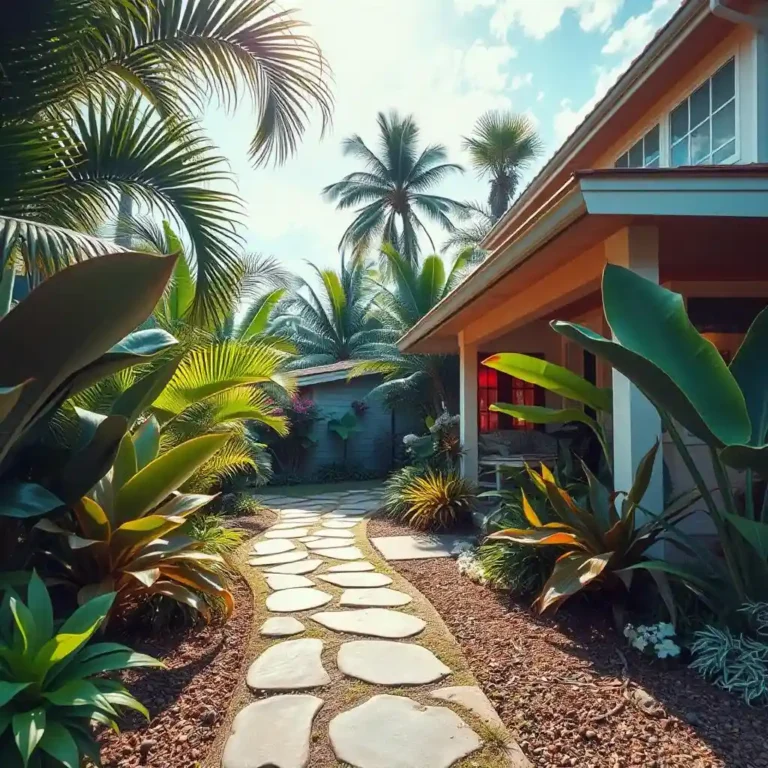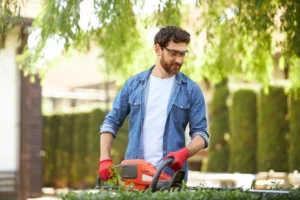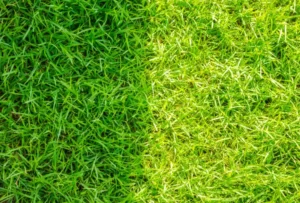Residential Tropical Landscape Design refers to the creation of outdoor spaces that embody the aesthetics and atmosphere of tropical climates, focusing on lush greenery, vibrant plants, water features, and open-air living areas. With Bay Area landscape design, homeowners can explore various tropical landscape ideas tailored to their unique environments, combining plants, materials, and elements that transform ordinary yards into tropical sanctuaries. Whether you’re seeking inspiration or looking to implement tropical landscaping ideas for your backyard, these designs offer beauty, function, and sustainability—even in climates that aren’t naturally tropical.
Definition and Characteristics of Tropical Landscape Design
Tropical landscape design is defined by:
- Lush, abundant plant life: Dense foliage with large leaves creates a vibrant environment. Palms, ferns, orchids, and hibiscus are staples in many tropical landscaping ideas for backyards.
- Vibrant colors: Bright reds, yellows, oranges, and purples contrast against deep greens, contributing to the vivid, lively character of the space.
- Natural, flowing shapes: Organic curves and irregular lines mimic the relaxed, untamed feel of tropical jungles.
- Moisture and humidity: Water is a core element, visually and functionally—seen in features like ponds, streams, and misting systems.
Key Elements of Tropical Landscape Design
Lush Greenery
- Trees and Shrubs: Tall palms and broad-leafed plants provide layered depth, essential to many popular tropical landscape ideas.
- Tropical Foliage: Signature leaves from banana plants, elephant ears, and birds of paradise establish a lush, exotic backdrop.
Exotic Plants
- Colorful Flowers: Orchids, bougainvillea, ginger, and heliconia introduce vibrant hues that energize the design.
- Tropical Fruit Trees: Mango, papaya, and coconut palms add ornamental and edible interest.
- Vines and Climbers: Used to cover walls and trellises, adding height and softness.
Water Features
- Waterfalls, Streams, and Ponds: These features are central to many tropical landscaping ideas for backyards, enhancing tranquility and soundscaping.
- Swimming Pools: Natural stone or lagoon-style pools blend into the environment.
- Aquatic Plants: Lilies and reeds introduce texture and help purify water.
Outdoor Living Spaces
- Covered Patios and Pergolas: Create inviting shaded areas that tie the indoor and outdoor spaces together.
- Outdoor Kitchens and Dining Areas: Perfect for entertaining while immersed in a tropical setting.
Benefits of a Tropical Landscape in Residential Settings
- Aesthetic Appeal: These lush environments are visually striking, offering countless tropical landscape ideas that can transform any property.
- Enhanced Privacy: Dense greenery acts as a natural screen, ideal for secluded backyard retreats.
- Stress Relief: The immersive natural setting helps reduce stress and enhance mental wellness.
- Increased Property Value: Professionally designed tropical backyards can significantly raise a home’s appeal and market value.
- Connection to Nature: Living among tropical plants and water elements fosters a deeper bond with the natural world.
- Energy Efficiency: Properly placed trees and foliage provide cooling shade, reducing the need for AC.
- Sustainability: Native and low-water plants can be used to create a tropical look with less environmental impact.
What is Residential Tropical Landscape Design?

Residential Tropical Landscape Design refers to the creation of outdoor spaces that embody the aesthetics and atmosphere of tropical climates, focusing on lush greenery, vibrant plants, water features, and open-air living areas. With Bay Area landscape design, you can achieve a tropical paradise tailored to your specific environment, incorporating the perfect balance of plants, materials, and features. The aim of Bay Area landscape design is to provide residents with a tranquil, nature-filled retreat, even in regions that may not naturally have tropical climates.
Definition and Characteristics of Tropical Landscape Design
Tropical landscape design is characterized by:
- Lush, abundant plant life: Dense foliage, often with large leaves, creating a vibrant and dense environment. Tropical plants like palms, ferns, orchids, and hibiscus are commonly used.
- Vibrant colors: A rich palette of greens, as well as the vivid hues of flowers and fruits, including red, yellow, orange, and purple, providing a bold contrast.
- Natural, flowing shapes: The design incorporates organic, curved lines rather than straight, geometric ones, evoking the natural forms found in tropical jungles and forests.
- Moisture and humidity: Water plays a significant role in both the aesthetic and functional aspects of tropical landscapes. They are designed to thrive in environments with high humidity and frequent rainfall.
Key Elements of Tropical Landscape Design
Lush Greenery:
- Trees and Shrubs: Tall palms, broad-leafed plants, and dense ground cover create a layered look, from the canopy to the undergrowth.
- Tropical Foliage: Large, glossy leaves like those of banana plants, elephant ear, and birds of paradise are central to creating a tropical atmosphere.
Exotic Plants:
- Colorful Flowers: Exotic flowers such as orchids, bougainvillea, ginger, and heliconia add vibrant colors to the design.
- Tropical Fruit Trees: Planting trees like mango, papaya, or coconut palms can add both beauty and practicality.
- Vines and Climbers: These plants can add height and coverage to the design, draping over walls, fences, and trellises.
Water Features:
- Waterfalls and Streams: Cascading waterfalls, koi ponds, and babbling brooks are essential to evoke the sounds and serenity of tropical nature.
- Swimming Pools: Integrated swimming pools with natural stone, fountains, or rock features blend seamlessly into the landscape.
- Ponds or Lagoons: Small water bodies that house aquatic plants and fish, creating a tranquil environment.
Outdoor Living Spaces:
- Covered Patios and Decks: These spaces provide a place for relaxation, dining, and entertainment while enjoying the tropical scenery.
- Pergolas and Gazebos: Structures like pergolas or gazebos offer shaded areas to relax, often covered in climbing plants.
- Outdoor Kitchens and Dining Areas: Al fresco dining setups that allow for cooking and entertaining outdoors, integrated with the surrounding tropical elements.
Benefits of a Tropical Landscape in Residential Settings
Aesthetic Appeal:
- Tropical landscapes offer a visually stunning environment with rich colors, textures, and natural beauty that make any residential property feel like a personal paradise.
Enhanced Privacy:
- The dense foliage and large plants provide natural barriers, creating private and intimate spaces in the garden, shielded from the outside world.
Stress Relief and Well-being:
- Living in or near lush, green spaces has been shown to reduce stress and improve overall mental well-being. The vibrant environment, coupled with soothing sounds from water features, helps to foster relaxation and calm.
Increased Property Value:
- A well-designed tropical landscape can increase the overall value of a home by creating an attractive outdoor space that is both functional and beautiful.
Connection to Nature:
- Tropical landscapes help foster a deeper connection to nature by immersing residents in a rich environment of plants, wildlife, and flowing water. This promotes a sense of tranquility and well-being.
Energy Efficiency:
- By strategically placing trees and large plants, tropical designs can provide natural shade and cooling, reducing the need for artificial air conditioning and lowering energy costs.
Sustainability:
- Tropical landscapes can support biodiversity by encouraging the growth of native and low-maintenance plant species, helping to conserve water and resources when designed with sustainability in mind.
Top 10 Residential Tropical Landscape Design Ideas

When designing a tropical landscape backyard, the goal is to create a lush, inviting environment that blends vibrant greenery, exotic plant life, and functional outdoor living spaces. These tropical landscape ideas will inspire you to transform your residential yard into a serene and stunning tropical paradise.
1. Lush Green Foliage and Layered Planting
Idea: Build depth and texture in your tropical landscape backyard by layering plants. Start with tall trees and palms, add medium-height shrubs and ferns, and finish with low ground covers.
Key Plants: Elephant ears, taro, hostas, ferns, ginger, and ornamental grasses.
Effect: Creates a vibrant jungle-like setting that adds shade, privacy, and a cooling effect.
2. Tropical Water Features (Waterfalls, Ponds, and Pools)
Idea: Water is essential in tropical settings. Incorporate soothing water features like waterfalls, koi ponds, or natural-style pools.
Key Features: Stone waterfalls, lily-filled ponds, and lagoon-style or infinity pools.
Effect: Enhances relaxation and introduces movement and sound to your tropical yard.
3. Outdoor Lounging Areas with Hammocks or Pergolas
Idea: Add cozy lounging spots like hammocks or pergolas to enjoy your tropical oasis.
Key Elements: Bamboo pergolas, hammocks between palm trees, and daybeds under leafy canopies.
Effect: Offers a shaded, peaceful retreat perfect for rest and relaxation.
4. Tropical Garden Walkways and Paths
Idea: Use natural materials to create winding paths through your tropical landscape backyard.
Key Features: Stone pavers, gravel trails, and wood plank paths surrounded by lush foliage.
Effect: Encourages exploration and guides visitors through your garden.
5. Incorporation of Colorful Flowers (Bougainvillea, Hibiscus)
Idea: Bright flowers are essential to many tropical landscape ideas. Use vivid blooms to contrast with greenery.
Key Flowers: Bougainvillea, hibiscus, plumeria, orchids, and ginger.
Effect: Adds vibrant pops of color that energize and enliven your garden.
6. Hardscape Elements (Stone, Bamboo, and Decking)
Idea: Balance soft plant textures with natural hardscaping. Use materials that complement the tropical aesthetic.
Key Materials: Bamboo fencing, flagstone patios, wood decking, and gravel areas.
Effect: Provides structure, walkways, and gathering areas while enhancing the natural feel.
7. Fire Pits and Outdoor Fireplaces
Idea: Extend your outdoor use into the evenings with cozy fire features.
Key Features: A stone fire pit or built-in outdoor fireplace, surrounded by seating.
Effect: Creates ambiance and makes your tropical space usable year-round.
8. Tropical Trees (Palms, Coconut, Banana) as Focal Points
Idea: Use tall, iconic tropical trees to define space and add vertical interest.
Key Trees: Coconut palms, royal palms, banana trees, and frangipani.
Effect: Draws the eye upward and reinforces the tropical theme with dramatic height.
9. Open-Air Outdoor Dining and Kitchen Spaces
Idea: Integrate cooking and dining into your backyard for the ultimate tropical lifestyle.
Key Features: Outdoor BBQ, pizza oven, dining table, and bar—all using natural, weatherproof materials.
Effect: Seamlessly blends indoor and outdoor living, ideal for entertaining.
10. Sustainable and Low-Maintenance Tropical Landscaping
Idea: Embrace environmentally conscious tropical landscape ideas by choosing native plants and eco-friendly systems.
Key Features: Drought-tolerant plants, mulch, rainwater collection, and solar lights.
Effect: Reduces maintenance and resource use while maintaining tropical aesthetics.
Small Residential Tropical Landscape Design
In small yards or urban settings, optimizing space is essential to create a functional, relaxing environment while maintaining a tropical feel. Limited space requires strategic design to ensure every inch is utilized effectively.
Design Strategies for Creating a Tropical Vibe in Small Spaces
Vertical Gardening:
- Use climbing plants, green walls, or vertical planters to maximize space.
- Plants like ivy, bougainvillea, or jasmine grow upward, saving ground space.
Compact Water Features:
- Incorporate miniature fountains or small ponds to create the calming sound of water without overwhelming the space.
Layered Plantings:
- Use tiered plant arrangements to add depth, with tall plants at the back and shorter plants in front.
- Maximize vertical and horizontal space for a lush, dense look.
Space-Saving Plants:
- Choose plants that are naturally compact or dwarf varieties like dwarf palms, ornamental grasses, or compact ferns.
- These plants thrive in small areas without overcrowding.
Maximizing Privacy:
- Use tall plants, bamboo screens, or trellises with climbing plants to create privacy and seclusion, making the space feel intimate and protected.
Modern Tropical Landscape Design

Modern tropical landscape design merges the lush, vibrant feel of the tropics with the clean, structured aesthetics of modern design. Ideal for those seeking a stylish yet natural retreat, this approach transforms a tropical landscape backyard into a luxurious, resort-like environment. By blending contemporary materials with exotic plants, homeowners can create an outdoor space that’s both sophisticated and welcoming.
Key Features of Modern Tropical Landscape Design
Sleek, Minimalist Approaches
Modern tropical landscaping ideas for backyard spaces emphasize simplicity and functionality.
- Uncluttered layouts allow the natural beauty of tropical plants to shine.
- Neutral or monochromatic color palettes help balance bold greenery.
- The design avoids excess ornamentation, maintaining a calm, cohesive aesthetic.
Geometric Shapes and Contemporary Materials
A modern tropical landscape backyard often features clean lines and sharp angles for contrast.
- Paving and pathways use geometric patterns to structure the space.
- Hardscape materials like concrete, stone, and glass offer a polished, contemporary look.
- Planters and garden beds often follow uniform or modular shapes.
Open Spaces and Seamless Indoor-Outdoor Flow
Creating a fluid transition between indoor and outdoor areas is central to the modern tropical approach.
- Large sliding glass doors, foldable panels, or floor-to-ceiling windows connect the house to the garden.
- Open-plan layouts encourage movement and visual continuity from the inside out.
Contemporary Furniture
Furniture selections reflect a modern lifestyle while enhancing tropical comfort.
- Think sleek loungers, minimalist outdoor dining sets, and sectional seating made from teak, powder-coated metals, or weather-resistant textiles.
- Modern pergolas or cabanas provide shaded lounge areas while contributing to the upscale aesthetic.
Dramatic Lighting
Lighting elevates both functionality and ambiance in a modern tropical landscape backyard.
- Spotlights and hidden LED lights accentuate plants, paths, and architectural details.
- Soft lighting around trees, water features, and seating areas creates a warm, inviting glow in the evening.
Resort-Like Atmosphere
A hallmark of modern tropical landscaping ideas for backyard settings is a sense of luxury and leisure.
- Infinity pools, sleek water features, and sculptural fire pits add elegance and serenity.
- Outdoor showers, shaded cabanas, and minimalist spas reinforce the resort-style experience.
- The overall vibe is tranquil, refined, and ideal for both relaxing and entertaining.
A modern tropical landscape backyard is perfect for homeowners who want a peaceful retreat with the style and amenities of a high-end resort. These tropical landscaping ideas for backyard design offer a unique blend of nature and modernism, proving that tropical can also be contemporary.
Simple Residential Tropical Landscape Design
A simple tropical landscape design focuses on creating a low-maintenance, serene outdoor space that embraces the natural beauty of tropical plants without overwhelming the senses. The design emphasizes minimalism, ease of care, and a calming atmosphere.
Key Elements for a Simple Design
Fewer Plant Varieties:
- Limit the number of plant species to reduce maintenance.
- Choose a few tropical plants that thrive in the local climate, such as palms, ferns, and grasses, to keep the design clean and easy to care for.
Focus on Greenery and Simplicity:
- Instead of vibrant floral displays, prioritize lush greenery with a few textured plants to create a peaceful, uncluttered look.
- Use plants with various leaf shapes and sizes for visual interest while maintaining a simple palette of green tones.
Naturalistic Hardscaping:
- Use natural materials like stone, gravel, or pebbles for paths, patios, or borders, which blend seamlessly into the tropical setting.
- Hardscaping elements should feel organic, enhancing the simplicity of the design without overpowering it.
Designing for Relaxation and Minimalism:
- Create open, uncluttered spaces designed for relaxation, such as a simple bench under a palm tree or a hammock.
- Focus on comfort and calm with clean lines and areas that invite contemplation or lounging.
Practical Tips for Beginners in Tropical Landscaping
- Choose Hardy, Low-Maintenance Plants: Select tropical plants that are easy to maintain, such as dwarf palms, sago palms, or snake plants, which require less watering and pruning.
- Use Mulch: Mulch helps retain moisture and reduces the need for frequent watering, making your tropical garden easier to care for.
- Plan for Simple Watering: Install an irrigation system or use drought-tolerant plants to minimize water needs and reduce upkeep.
- Maintain Regular Pruning: Regularly trim any overgrown plants to keep the garden looking neat and manageable.
- Embrace Minimalism: Keep furniture and decor simple. A few functional, well-placed items like a chair or small table can enhance the atmosphere without cluttering the space.
Final Thoughts
We specialize in designing beautiful, functional, and sustainable tropical landscapes customized to fit your unique space. Whether you’re looking for a lush, vibrant tropical paradise or a simple, low-maintenance retreat, our team of experts is here to help bring your vision to life. With a focus on quality, creativity, and attention to detail, we ensure your outdoor environment becomes a seamless extension of your home. Contact Lakota Design Group today to transform your residential landscape into a stunning, resort-like oasis you’ll love to enjoy for years to come.
FAQs
How Can I Create A Tropical Landscape Design For My Small Yard?
Creating a tropical landscape for a small yard involves maximizing space with clever design strategies. Some ideas include using vertical gardening (climbing plants or green walls), selecting compact tropical plants (such as dwarf palms or ornamental grasses), incorporating small water features (like mini ponds or fountains), and ensuring the use of layered plantings to create depth without overcrowding the space.
What Are The Benefits Of A Residential Tropical Landscape Design?
Tropical landscapes offer several benefits, including:
- Aesthetic appeal: They provide a lush, vibrant environment that enhances the beauty of your home.
- Relaxation: The tropical atmosphere promotes relaxation and stress relief, offering a private retreat.
- Environmental advantages: These designs can help improve air quality and reduce the urban heat island effect.
- Increased property value: A well-designed tropical landscape can raise the curb appeal and value of your home.
What Plants Are Best For Residential Tropical Landscape Design?
Some popular tropical plants for residential landscapes include:
- Palms (Coconut, Queen Palm, Areca Palm)
- Hibiscus (for vibrant flowers)
- Bird of Paradise (striking flowers)
- Bamboo (for privacy and texture)
- Banana trees (for a tropical feel)
- Tropical ferns and orchids (for lush greenery) These plants thrive in warm, humid environments and provide a true tropical look.





